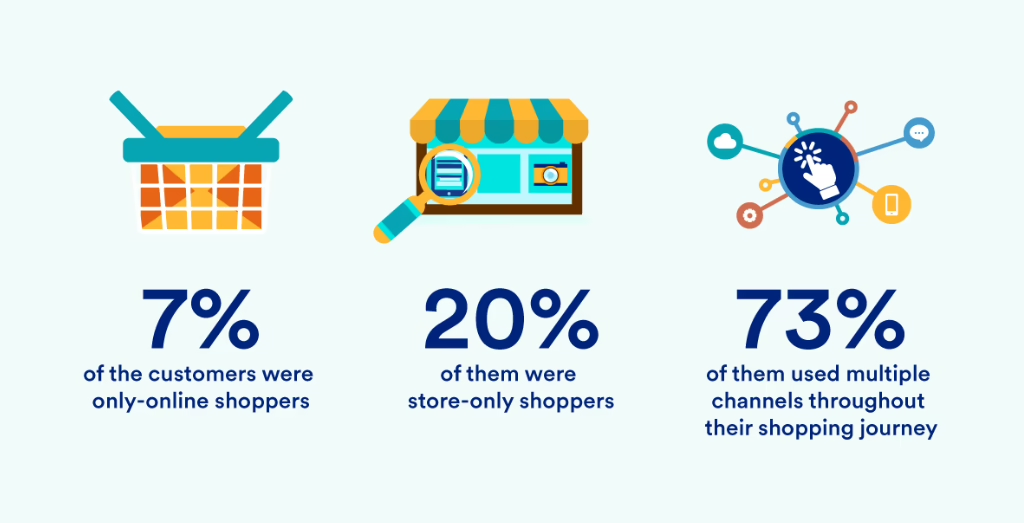
The ecommerce revolution has already taken over our lives, wallets, and shopping habits! Remember when “online shopping” meant nervously typing your credit card number while wondering if that package would ever actually show up? Those days are long gone. Today, we are tapping, swiping, and voice-commanding our way to $6.3 TRILLION in global online sales […]

The ecommerce revolution has already taken over our lives, wallets, and shopping habits! Remember when “online shopping” meant nervously typing your credit card number while wondering if that package would ever actually show up? Those days are long gone.
Today, we are tapping, swiping, and voice-commanding our way to $6.3 TRILLION in global online sales this year alone. That is not just a big number, that is an economy-transforming, industry-disrupting kind of big.
Whether you are a retail giant scrambling to keep up, a scrappy startup dreaming of digital domination, or just someone who can not stop clicking “add to cart” at midnight, these stats tell the wild story of how we have collectively moved our shopping from malls to mobile phones.
So buckle up for this rollercoaster ride through the mind-blowing numbers behind our collective online shopping addiction!
$8 TRILLION is not just a big number, that is an absolutely staggering figure that will have you worried about your online shopping habits! This massive number of retail ecommerce sales shows just how dependent we have all become on shopping from our couches. With every click and tap, we are contributing to this digital shopping tsunami that is reshaping the entire economy.
Nearly a quarter of EVERYTHING being bought happens online now! Traditional brick-and-mortar stores are watching anxiously as more and more shoppers skip the parking lots and checkout lines in favor of digital carts. It is a fundamental shift in how we shop.
2.77 BILLION online shoppers? That Is more than a quarter of everyone on Earth clicking “buy now”! Each of these shoppers represents a potential customer for an emarketer.
Nearly three-quarters of all online purchases are happening on phones and tablets. We are buying everything from groceries to furniture while standing in line for coffee or lounging in bed. For businesses with clunky mobile sites, you are essentially turning away 8 out of 10 potential customers. The message for online retail couldn’t be clearer: optimize for mobile commerce or watch your competitors steal your customers.
Almost 70% of shopping carts are abandoned at checkout. This painful statistic reveals the fragility of the online purchase journey. One surprise fee, a complicated checkout form, or a moment of hesitation, and poof, the sale vanishes. Leading online retailers are obsessing over every detail of their checkout process to stop this retail heartbreak.
Three-quarters of shoppers now EXPECT free shipping. It is no longer a perk, it is a requirement! Shipping costs can make or break the purchase decision. For online retailers, building shipping costs into product pricing might be the only way to satisfy these expectations without sacrificing margins.
Social media platforms are turning into $1.6 TRILLION shopping malls. Our Instagram and TikTok feeds are not just for entertainment anymore, they are becoming powerful purchasing channels. That casual scrolling is turning into serious shopping via social media.
Voice shopping is no longer futuristic, it is a $80 BILLION reality! How easy they have made it to spend money without even looking at a screen. Smart speakers and voice assistants have quietly infiltrated our homes, and now they are infiltrating our shopping habits too.
$95 billion for boxes of stuff that show up at your door every month? The subscription economy is booming! From meal kits to beauty products to mystery boxes, we are all falling in love with the thrill of regular curated deliveries. For brands still relying on one-time purchases, you are missing out on the recurring revenue and the deep customer relationships that subscription models build and help increase the conversion rate.
The retail king has created such a robust ecosystem that over a third of all digital shopping revenue passes through their platform. The blend of vast choices, attractive pricing, and rapid delivery has established customer expectations that other retailers find hard to meet. For sellers, Amazon provides access to a vast pool of customers.
Over 2 MILLION businesses now run on Shopify. Shopify has become the go-to platform for businesses looking to establish independence from marketplaces like Amazon. The platform has democratized ecommerce, making it possible for anyone with a product to create a professional online store without technical expertise. For entrepreneurs sitting on the sidelines, these numbers should convince you that the barriers to entry have never been lower!
With a 12% growth in buyers, eBay is proving it has a significant pull in the ecommerce landscape. Its auction format and vast selection of unique, vintage, and hard-to-find items continue to attract shoppers looking for something different. eBay offers access to a massive global audience of buyers who come specifically looking for the unusual and the unique.
The convenience of stored payment information and enhanced security features have made digital wallets the preferred way to pay online. This widespread adoption in the ecommerce industry is reshaping checkout experiences across the web. For ecommerce businesses still forcing customers to manually enter card details, you are adding unnecessary friction that is driving customers away.
$834 BILLION in “buy now, pay later” transactions is equal to the GDP of Switzerland! The BNPL revolution is completely transforming how people think about purchasing power. By breaking payments into interest-free installments, these services are making higher-ticket items more accessible to average consumers.
The Amazon effect has completely warped our patience levels! Remember when waiting 5-7 business days was perfectly normal? Now we want the package at our door within hours! This expectation for instant gratification is putting enormous pressure on retailers of all sizes to completely reimagine their logistics operations.
Nearly 60% of retailers are now using AI to personalize shopping experiences. Those product recommendations that know exactly what you want before you do? That Is AI working its magic. The personalization revolution is well underway, and customers are quickly learning to expect experiences tailored specifically to their preferences.
According to Statista, virtual try-before-you-buy is becoming the new normal! The days of guessing how a couch will look in your living room or whether those glasses will suit your face are rapidly disappearing. AR is bridging the gap between online convenience and in-store confidence.
Asia-Pacific is dominating the ecommerce scene with the biggest market, with nearly 60% of all online sales worldwide. We are seeing massive digital adoption sweeping across countries like China, India, and Southeast Asia, where millions of consumers are skipping traditional retail entirely and diving headfirst into mobile shopping. The future of ecommerce has clearly shifted east.
Europe is bringing some numbers to the table with 18% yearly growth! For a region known for its traditional shopping culture and charming brick-and-mortar boutiques, that is pretty impressive.
Companies in the United States and Canada are moving everything online, from groceries to furniture to luxury goods. The challenge for businesses is not convincing people to shop online anymore, it is standing out in a crowd where everyone is shouting for attention. Getting noticed in this trillion-dollar marketplace requires something special.
Two-thirds of online retailers are increasing their cybersecurity budgets this year. Those data breaches have businesses sweating, and for good reason. One security slip-up can send customers running faster than a site-wide “404 Error.”
Nearly 80% of shoppers get the heebie-jeebies about their personal data. Every time we hit “create account,” we are handing over our digital DNA. Shoppers are getting savvier about who they share their details with, wondering if the email address they provided is being passed around. The trust landscape has gotten so shaky that businesses with rock-solid privacy practices can actually turn it into a competitive advantage.
$48 billion lost to online scammers this year? That’s the dark side of the ecommerce boom, a thriving ecosystem of fraudsters getting more sophisticated by the day. From fake chargebacks to account takeovers to identity theft, these digital thieves are everywhere. These are not just financial losses, they are reputation killers that can make customers go away.
IoT in e-commerce is growing 20% year over year. The Internet of Things is turning our homes into autonomous shopping centers, from washing machines that reorder detergent to pantries that keep track of what is running low. For retailers, this is next-level integration into consumers’ lives.
Around a third of online stores in U.S. are now accepting crypto. What was once considered fringe technology is rapidly becoming a standard payment option in the ecommerce landscape. For retailers, crypto payments offer the potential for lower transaction fees and access to tech-savvy customer segments.
Almost two-thirds of shoppers are now voting for planet-friendly products. Sustainability has gone mainstream! Consumers are checking packaging, scrutinizing supply chains, and side-eyeing brands with sketchy environmental practices. Today’s shoppers want a real commitment to sustainability.

Nearly three-quarters of shoppers are bouncing between your website, app, social media, and physical stores. Today’s shopping journey includes researching on mobile, checking reviews on social media platforms, popping into a store to touch the product, then finally buying online.
People prefer being treated like individuals rather than anonymous wallet carriers! A whopping 80% of shoppers are more likely to buy when you make them feel special with personalized experiences. Those generic “Dear Valued Customer” emails and random product recommendations are not just ineffective anymore. Today’s shoppers expect you to remember their preferences, anticipate their needs, and make relevant suggestions.
While traditional retail jobs might be shrinking, ecommerce is creating 15 million new positions. We are seeing entire new career paths pop up, from warehouse automation specialists to last-mile delivery experts to digital merchandising ninjas. The retail employment landscape is not dying; it is just getting a major makeover! These new jobs often require different skills than traditional retail, creating both opportunity and challenge for workers looking to make the transition to digital commerce.
More than half of SMEs are finding international customers thanks to digital platforms. A small store in a tiny town can sell to shoppers across the planet without needing a massive investment or corporate infrastructure. Shipping products across borders brings its own headaches. But the barriers to going global have never been lower.
AI is bringing $400 billion in extra sales to the table! From accurate product recommendations to chatbots that understand exactly what you are asking, artificial intelligence is making online shopping freakishly efficient. Behind the scenes, AI is working overtime, optimizing inventory, personalizing marketing, and even predicting the next season’s hot products.
Well, there you have it, folks – the digital shopping revolution in all its trillion-dollar glory! From AI personal shoppers to your fridge ordering milk before you realize you are out, ecommerce has transformed from a convenient option to the beating heart of global retail.
The numbers don’t lie: with nearly a quarter of ALL shopping happening online, crypto payments going mainstream, and sustainability becoming non-negotiable, we are witnessing retail history being rewritten in real time.
For businesses, the writing’s on the digital wall: adapt or watch your competitors zoom past you while you are still arranging mannequins. For consumers, our collective clicking power is reshaping entire industries and creating millions of new jobs along the way.
Whether we are shopping from our couches in North America or mobile phones in Asia-Pacific, one thing is crystal clear – this ecommerce train has left the station, picked up serious speed, and is barreling toward that $8 trillion future faster than same-day delivery.
Happy (digital) shopping, everyone!


